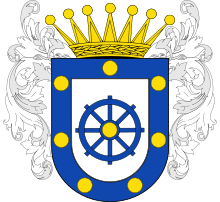Good knoop
Gut Knoop is the name of an estate that is now west of Kiel-Holtenau near the former Eider Canal in the municipality of Altenholz on the Kiel Canal .
history
The estate was first mentioned in a document in 1322. The name means something like knob or hump in Low German . The founder of the estate may have been the Lupus de Knope (Wulf / Wolf von Knoop) mentioned in 1322 , who had acquired the relevant land shortly before. The name Wulf / Wolf can still be found in the coat of arms of the Altenholz community: a wolf leaping high on a tree.
Knoop was successively owned by those of Knoop, von der Wisch and von Rantzau . The estate was owned by the Saxon nobility, although it was north of the Levensau and thus in the Duchy of Schleswig . In the 16th century, the then owner Paul von Rantzau had the moated castle Knoop ( "Arx Cnopia" ) built. The house had a windowless ground floor or "water floor", two floors and on the gable roof three bay windows on each side was surrounded by moats that were fed from the Levensau.
In 1632 the Danish King Christian IV bought the estate of Cai von Ahlefeldt , who had acquired it shortly before because he wanted to build the Christianspries fortress on the land belonging to it. After the Thirty Years' War ended in 1648, he sold the estate to Friedrich von Buchwaldt . Through the marriage of Dorothee von Buchwald (1683–1709) to Wolf Heinrich von Baudissin , Knoop fell to the Baudissin family .
1776 had become rich through plantations in the Danish West Indies, and by slave trade merchant bought Heinrich Schimmelmann (1724-1782) of the impoverished family Baudissin from the estate Knoop to make it to his daughter, the later writer Caroline Adelheid Cornelia (1759-1826) as a dowry for to leave her marriage to Heinrich Friedrich Graf von Baudissin (1753–1818). Caroline von Baudissin had today's mansion built from her father's inheritance a little west of the castle and furnished it. The old moated castle was then torn down and the ditch filled in. Together with Gut Emkendorf , which Caroline's sister Julia von Reventlow lived in with her husband Friedrich , Knoop was one of the cultural centers of Schleswig-Holstein around 1800 . It was not until 1805 that was serfdom abolished.
In 1869 the estate was sold by Eduard von Baudissin - not least because of the gambling debts left by Caroline - to the Danish merchant Ingward Martin Clausen, who - like the Schimmelmanns - had become prosperous in the Danish West Indies . After Clausen's death in 1903, the estate passed to the Bremen tobacco merchant Heinrich Gerhard Richard Hirschfeld, whose family still lives on Gut Knoop today.
building
The manor of the estate was built from 1792 to 1796 according to the plans of the Danish architect Axel Bundsen in the classical style and the facade was aligned with the Eider Canal, which was opened in 1784, and surrounded by a landscape park designed by Carl Gottlob Horn , which included the banks of the Eider Canal. Thanks to Schimmelmann's fortune, it was richly furnished by artists such as Ludwig Philipp Strack and the Italians Giuseppe Anselmo Pellicia and Francesco Antonio Tadey, who were also active in Emkendorf . The building with the mighty portico is one of the outstanding works of classicism in Schleswig-Holstein. The landscape park was largely destroyed when the Northeast Sea Canal was built in 1895. Most of the furnishings have been preserved.
The so-called tea house is also located on the estate. It was built in 1910 by the artist and architect Rudolf Alexander Schröder from Bremen on a site where a wooden pavilion had previously been located. The building, also known as the Doric Temple , is 20 m² in size and was renovated in 2008 for 60,000 euros.
The manor house is privately owned; but it can be viewed after registration. Cultural events take place regularly in some rooms. The tea house is open to the public and can also be used for civil weddings.

Knooper lock
The Eider Canal ran east of Gut Knoop with the second Knooper lock - after the first lock in Holtenau - including a Dutch-style bascule bridge . Approx. 3 km as the crow flies from the estate in a north-westerly direction is the renovated structure of the former Rathmannsdorf lock , which, unlike the Knooper lock, had no bridge.
Web links
- Green paths - Gut Knoop
- History of the Knoop estate with illustrations
- Gut Knoop in the Alexander Duncker Collection (PDF; 229 kB)
swell
- Schleswig-Holstein State Archives : Monasteries and estates. Dept. 195: Schleswig noble estates and rural communities. Dept. 195.45: Knoop, Gut.
literature
- Henning v. Rumohr: Castles and mansions in the Duchy of Schleswig , newly edited. by Cai Asmus v. Rumohr, 1987, Verlag Weidlich Würzburg, 3rd edition, ISBN 3-8035-1302-2 , p. 372.
- Deert Lafrenz: manors and manors in Schleswig-Holstein . Published by the State Office for Monument Preservation Schleswig-Holstein, 2015, Michael Imhof Verlag Petersberg, 2nd edition, ISBN 978-3-86568-971-9 , p. 306
Individual evidence
- ↑ Holtenau Info: The Knoop Estate. Depiction of the old moated castle
- ^ Hermann Baasch: Ninety Years. Notes from my life . In: Yearbook of the home community Eckernförde e. V. year 34/1976.
- ↑ Good Knoop. In: schleswig-holstein.de. Archived from the original on May 3, 2010 ; accessed on April 22, 2018 .
- ↑ Topographic map of Kiel on a scale of 1: 50,000, edition from 1962.
- ^ Jürgen Jensen: Kiel Canal Bridges . Boyens, Heide 2010, ISBN 978-3-8042-1309-8 , pp. 10-12.
Coordinates: 54 ° 22 '24.2 " N , 10 ° 6' 9.1" E



